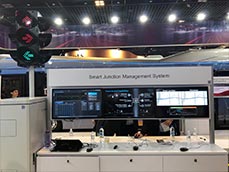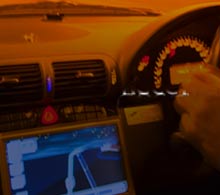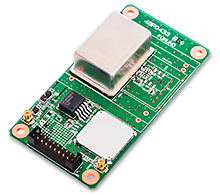Articles for ITS market
Commercialization and monetization of MaaS
- ITS World Congress Singapore Report -
 ITS World Congress Opening Ceremony in Singapore
ITS World Congress Opening Ceremony in Singapore
 Singapore's EV sharing car lined up outside the conference venue
Singapore's EV sharing car lined up outside the conference venue
 NAV INFO digital map information is essential for MaaS and automated driving
NAV INFO digital map information is essential for MaaS and automated driving
Actual MaaS demonstration experiment results
The ITS World Congress is a world meeting where stakeholders from all over the world meet to discuss ITS (Intelligent Transportation Systems). This year it was held in Singapore.
The number of registered registrants reached 10,000, of which 6500 are foreign residents.
The conference incorporates a planetary style session where 300 to 400 people participate and where about 100 people participate and delve into the technology and legal development of each department.
In the session there were many agendas related to so-called CASE (Connectivity, Autonomous, Shared, Electric). These include communication connectivity, automated driving, sharing economy, and EV (electric vehicle).
There is also an impression that discussions about road infrastructure and city planning, which are often handled at the ITS World Congress, have deepened.
The author focused on sessions including autonomous driving, MaaS (Mobility as a Service), and urban planning. The author was interested in MaaS-related sessions regarding monetization potential.
There is currently no clear definition of the MaaS theory. In general, the degree of transfer freedom is improved by utilizing public transportation such as railways, buses and new transportation methods such as ride sharing. To utilize the user can use a personal device such as a smartphone with the usage fee being a flat rate “subscription”.
Under such conditions various MaaS demonstration tests are being conducted around the world. However, there are few achievements that lead to a profitable business model.
To overcome this situation, Singapore LTA (Land Transport Authority) held a MaaS global special session forum for half a day.
In this discussion, examples of successful cases from the City of Los Angeles, California and the Department of Transportation (DOT) in Washington, USA were introduced. However these areas have larger income levels such as corporate tax and personal income tax. There is also a large interest to actively invest in MaaS. Moreover, because it is developed as a public project, its business model is basically as a non-profit .
In MaaS demonstration tests in Germany and Finland, the author reaffirmed that there are few public transport stakeholders in both regions, making it easy to build a data platform for MaaS. Eventually MaaS will alleviate traffic congestion by increasing traffic efficiency in urban areas and reduce the situation that delays development of the local economy.
Alternately, MaaS from a small population area also participated in the discussion during another session. In this case study it is difficult to make similar and stable income compared to urban areas. Most cannot exceed the local government and public works framework. There is a strong impression that NPOs only make social contributions.
In fact, as an evolutionary ambassador for Eiheiji-cho, Fukui Prefecture with a population of 18,000, I am continuously discussing the regional version of MaaS with Fukui transportation operators and local residents. I constantly feel the difficulties when trying to influence them.
Aiming to become the de facto standard, the Chinese lineup will increase its presence
For a different perspective, take another look at this ITS World Congress.
China, where the number of cars sold this year has been sluggish due to the US-China trade friction issue ITS is deepening cooperation with government agencies and companies in other countries with a medium to long-term view as a national policy.
Since ITS is deeply related to IT technology, it has been thought that BAT (Baidu, Alibaba, Tencent) called China IT Big 3 continues to be a big presence.
However, looking at the movements related to ITS in China since last year, including the ITS World Congress, BAT is providing support for the ITS business. Is is not the front stage, such as providing a base for digital map information. Instead of BAT, Huawei, a major communications infrastructure including smartphones, ST Engineering and a major heavy industry are appearing on the ITS World Congress stage. Speaking of Japan, ST Engineering is a huge company that is a fusion of Mitsubishi Heavy Industries, Hitachi, Toshiba, Fujitsu, etc. It is engaged in businesses related to railways, military demand, and road infrastructure. I participated in a joint session between ST Engineering and Huawei and felt the cooperation between the two companies was quite strong.
What they emphasized in the presentation was building a data platform for MaaS. They aim to become a de facto standard that uses common APIs and cooperates with various operators in China.
The most important thing in commercializing MaaS is to ensure a stable supply of data platforms. In Japan, the MaaS data platform has been discussed with the participation of Eiheiji Town in the demonstration of the “Smart Mobility Challenge”. This is jointly conducted by the Ministry of Economy, Trade and Industry and the Ministry of Land, Infrastructure, Transport and Tourism since FY2019. However, currently no solution has been found.
Under such circumstances, China, which has extremely strong government leadership, is currently promoting a strong lineup that puts Huawei and ST Engineering together while minimizing BAT. I feel a bit uneasy about the future of Japan’s influence.
I will continue to cover MaaS and ITS in various parts of the world and in Japan while considering the future of Japan’s society.
Writer introduction

Mr. Kenji Momota Automotive journalist
His major is the world automotive industry and he is also familiar with the energy industry, IT and the aging society problem as the related fields. He acts around the world based in Japan and USA and writes for the general magazines, the technology journals and the automotive related media etc.
He is also commentator of motor race and world's motor show on TV program based on his career of the driver of Indy Racing League and NASCAR. In recent years, he has been covering about a paradigm shift from developed countries to developing countries, the motorized vehicle like EV and the telematics.
FURUNO ITS Journal
Click here for the latest articles after 2022 (in Japanese)2022
- The "realistic" self-driving roadmap shown by the Japanese government and a hands-on report on the latest Subaru EyeSight X
- Will FCVs (Fuel Cell Vehicles) Become Popular? ~New Movement in Toyota and Honda~
- The 'Complete' online sales of new cars start in Japan. Will this new way of buying cars take root?
- Many Firsts! On-Site Report from Tokyo Auto Salon 2022 - The author, who knows what goes on behind the scenes, looks back on 40 years of history. -
2021
- "Moving toward zero traffic fatalities for four-wheeled and two-wheeled vehicles globally in 2050" ~Experience on Honda's latest safety technologies~
- Tsuneishi Shipbuilding's building and DX, an exclusive visit to the main factory
- Japan's Smart City: New Moves toward Practical Use
- When will self-driving buses (service cars) be put to "full-scale" practical use?
- Utilization vehicle data during disasters
- Toyota-led Connected Technology to Transform Commercial Vehicle Business -From light trucks to large trucks and buses-
- Toyota enters the connected car "Personalization" business
- Japanese automakers' carbon-neutral strategies swept up in ESG investment
- Drive experience of the latest autonomous vehicle models and advanced driving support systems
- Will carbon neutrality accelerate the trend to strengthen LCA (Life Cycle Assessment)?
- Semiconductor shortage exposes realities of the automotive industry
- Online Autonomous Driving Contest Enhancing development of Human Resources
2020
- What happens to CASE when gas cars are banned in Japan?
- When will Flying Cars be launched?
- Expectation vs. reality:Autonomous Driving in Japan
- V2X, Becoming increasingly important in autonomous driving
- Technology of Subaru “EyeSight X”
- Lifestyle-oriented French cars gain popularity in Japan
- Human-oriented smart cities are wanted
- MaaS and CASE, how would automotive industry change after COVID-19?
- The beginning of virtualization era, triggered by COVID-19
- Trend of EV shift and consumer demands
- TOYOTA Press conference about ADAS - Releasing algorithm for "sudden acceleration suppression during attempted sudden acceleration" free of charge -
- The Japanese automotive industry in 2020 - 3 turning points -
- "Using a smartphone while driving" and "Level 3 automated driving"
2019
- Motor show business model is at a turning point - Tokyo Motor Show Report -
- Commercialization and monetization of MaaS - ITS World Congress Singapore Report -
- Android Automotive pays attention to V2X - Report from the Frankfurt Motor Show 2019 in Germany -
- Automobile Distribution Revolution and DCM (Data Communication Module)
- Connected business potential and newly proposed "eMaaS" by Honda
- 5G services for practical use are multiplying
- Connectivity technologies attracting attention due to frequent traffic accidents
- Shanghai Motor Show report -SUV, EV, Automated car & 5G-
- Drone Business roadmap and updates to Michibiki (Quasi-Zenith Satellite System)
- MaaS (Mobility as a Service) "town development." Full-scale promotion for a national project
- CES organizer states "Data Period in 2020s." Transformation of the Automotive Industry in CES, US "-CES2019 Report-"
- "Return to Origin" directed towards the age of change, automatic operation and connectivity
2018
- New proposal for Private Car Automated Driving Level and other Hot 5G Technology Topics
- Standardized EV charging infrastructure concerns in Europe, US, Japan and China - Kobe EVS 31 field report -
- Touring a pure car carrier and a test drive of the latest hybrid car
- Planning stage products are exhibited at the newly established visualized mobility service "TOYOTA MOBILITY SHOWROOM".
- Potential “Community Car-share” program promoted by local residents
- CES Asia Report 2108
- Companies attempt new Vehicle-to-Infrastructure communications, including traffic volume measurements and vehicle positioning. -ITS Asia Pacific Forum in Fukuoka-
- Geneva show in Switzerland. Flying cars and MaaS (Mobility as a Service) were hot topics.
- EV (Electric Vehicle) proposals by country
- MaaS competition through service mobilization, M & A and technical field collaboration is accelerating. - The CES 2018 Report -
2017
- Big data’s initiative and fight for the automotive industry. Cooperation among companies becomes increasingly important.
- Connected car and road-to-vehicle communication automatic operation
- ETC (Electronic Toll Collection) and ETC2.0. Current situation and projected future
- Rapid development of sharing economy
- Germany is first to recognize level 3 automated driving
- ITS EU 2017 Field Reports -Automatic Operation and the eCall-
- From Infotainment to ITS, the competitive area is spreading in the car big data industry.
- GTC (GPU Technology Conference) Report and the de facto standardization of AI (artificial intelligence)
- Renesas' new challenge! "e-AI Solution" and "Renesas Autonomy"
- The Automobile industry is shifting from a manufacturing industry to a service industry.
- The movement toward accident countermeasures for aging drivers in Japan
- Fusion of ride sharing and fully automated driving is advancing in the USA.
2016
- Overview of the Quasi-Zenith Satellite System (QZSS) and advancements toward full-scale practical use including the Tokyo Olympic Games - G-space EXPO 2016 report-
- Japan’s automated driving project "SIP-adus" will be a large demonstration experiment.
- The International Home Care & Rehabilitation Exhibition. There were many car manufactures with exhibits booths at this show.
- Japanese car manufacturers starting to concentrate on strengthening the ADAS system
- A new movement of legislation for autonomous cars
- Cyber Security and “AGL”, the new OS for automotive are hot topics in the connected car industry
- “High precision 3D map” the key future of autonomous car and pedestrian dead reckoning
- Chinese “BAT” is accelerating their business in the EV (Electric Vehicle) market
- Tesla's original connection to Taiwan and the new transportation system technologies.
- "The main topic" of the Geneva Motor Show was how to strengthen "pedestrian protection"
- The probe data business is getting more competitive
- Reporting directly from the 2016 CES show "Data services will soon become the main revenue source of automotive industry"
2015
- Do the automated driving systems need the GNSS (Global Navigation Satellite System) ?
- ETC Version 2.0 is coming soon. A new service was announced at the Tokyo Motor Show and the possibility that is could be used as a device for older drivers.
- "Connected Horizon" and "eHorizon". Germany's leading parts supplier accelerates strengthening of "Big Data" for business



 Continental level 4 automated driving vehicle
Continental level 4 automated driving vehicle Huawei booth
Huawei booth ST Engineering Traffic Control System
ST Engineering Traffic Control System GPS/GNSS Receiver&Chips and Modules (positioning and timing)
GPS/GNSS Receiver&Chips and Modules (positioning and timing)